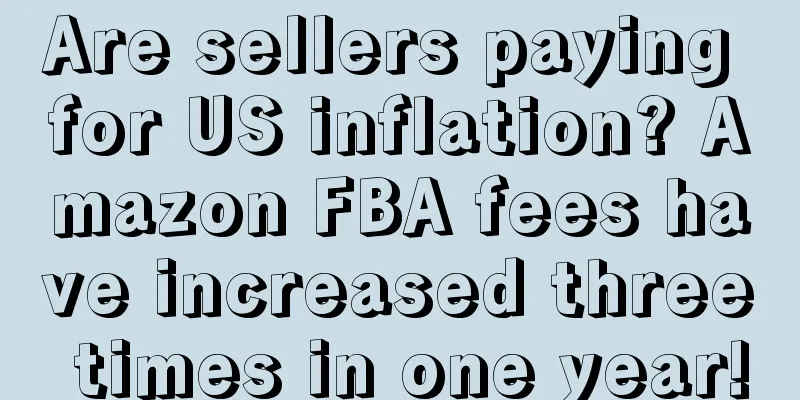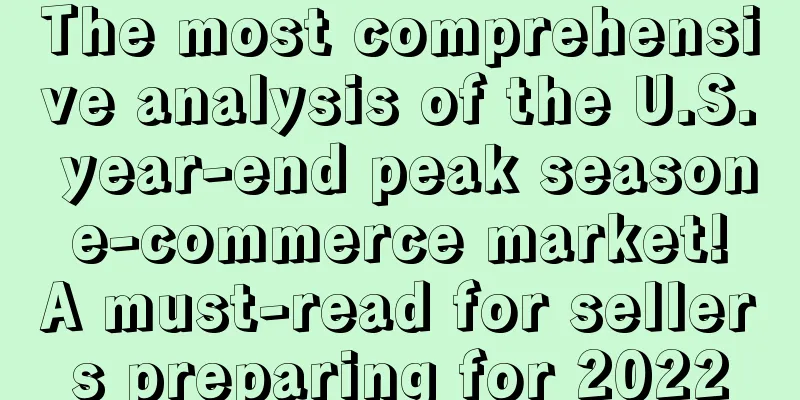Are sellers paying for US inflation? Amazon FBA fees have increased three times in one year!

|
It is learned that Amazon officially announced today that it will charge a "Holiday Peak Fulfillment Fee" for products using FBA in the United States and Canada from October 15, 2022 to January 14, 2023. The average charge per item is $0.35 , which varies depending on size and weight.
▲ The picture comes from Amazon US Amazon said it made the decision because during the holiday sales peak season, freight volume is highly concentrated and the order processing and delivery costs of the entire industry will face tremendous pressure, so it had to do so.
In addition, Amazon also stated in the announcement that even after this change, Amazon's regular logistics delivery fees are still more than 30% cheaper than third-party logistics providers , and next-day delivery fees are 70% cheaper .
In fact, it is not new for logistics companies to charge extra fees during peak seasons. There have been many cases of this in previous years. Before Amazon announced the price increase, FedEx and USPS had charged "peak" surcharges on the grounds of high costs.
On August 10, FedEx announced that it would start collecting 2022 peak season surcharges ahead of schedule: the first round will start on September 5 , with a fee of $3.45 per package . The second round of surcharges will start on October 3 , at $6.55 per package , and will last until January 15. FedEx will also apply certain surcharges based on weekly calculations starting in mid-October to early December.
▲ The picture comes from Fedex official website On the same day that FedEx announced the price increase, USPS (United States Postal Service) also announced on its official website a temporary rate adjustment plan for peak season package delivery services in the United States. The content shows that the peak season rate is temporarily adjusted from October 3 to January 22 , ranging from 25 cents to $5.85 depending on the weight and distance of the package .
It is not just logistics companies that are affected by seasonality. Against the backdrop of global inflation this year, workers have gone on strike at ports around the world, causing increasing port congestion. With the arrival of the peak shipping season in August, many shipping companies have also announced that they will increase charges :
Earlier this month, Maersk announced that it would impose a peak season surcharge (PSS) on some routes from August 16, including $750 per 20-foot container and $1,500 per 40-45-foot high container . MSC Mediterranean Shipping also announced that it would impose a service disruption surcharge (SDS) from August 15, which would apply to all goods shipped from Asia to northwest Europe .
For cross-border sellers in North America, Black Friday and Cyber Monday at the end of the year are a super promotion season that cannot be missed. The order volume will grow explosively during the event, and the time period for Amazon to increase the peak season surcharge basically coincides with the event.
Although the reasons for the price increase seem sufficient, today's cross-border sellers are in a state of internal competition, with declining orders and profits squeezed to a very low level. In addition, Amazon has already raised FBA delivery fees twice in the first half of this year, and this fee increase has unsurprisingly caused a strong reaction from sellers.
On January 18 this year , Amazon raised the FBA delivery fee rate across the board, with an average increase of 9% , and used the maximum value of the weight or volume weight to determine the delivery weight for large items. On April 28, Amazon announced that it would impose a 5% fuel and inflation surcharge on top of the current FBA delivery fee per item due to fuel prices and inflation. Although Amazon stated that this fee is not a permanent fee, it has not been cancelled so far.
Including this peak season surcharge, Amazon has raised FBA prices three times in less than 8 months. As soon as the news came out, it immediately caused an uproar in the industry. On the forum, sellers began to criticize Amazon.
One seller said: "The profits are getting lower and lower, the orders are getting worse and worse, and the official prices are constantly increasing. I am ready to change my business."
▲ The picture comes from Zhiwubuyan Some sellers also expressed doubts: Amazon’s difficulties must mean raising prices for us? Where is the so-called peak season ?
But the matter is done, and Amazon obviously cannot withdraw its decision to raise prices. What sellers are most worried about right now is the profit issue . If they raise prices, they may lose orders due to the fierce competition from competitors, and if they do not raise prices, they will hardly make any profit .
"Some high-volume products don't even have a profit of 0.35. If I want to raise the price a little, Amazon will kill me."
▲ The picture comes from Zhiwubuyan But there are also some stubborn sellers who say they will never compromise. "Last time FBA raised the price, I raised the price by one dollar. This time Amazon raised the price, I will follow suit . It's up to Americans to buy or not!"
▲ The picture comes from Zhiwubuyan This view has been supported by many sellers. Unlike in the past, in this discussion, more and more sellers have decided to raise prices to fight the policy, rather than silently endure the pressure from both officials and opponents.
▲ The picture comes from Zhiwubuyan
▲ The picture comes from Zhiwubuyan As early as June, when Andy Jassy announced the reduction of Amazon's warehousing scale, some sellers speculated that if Amazon failed to eliminate overcapacity and solve cost problems in the second half of the year, it would most likely choose to increase delivery fees. The current situation has verified this speculation.
It is true that official policies are one factor, but the endless price involution of sellers is also one of the factors that have led to the continuous decline of the cross-border e-commerce market environment. In the face of rising delivery costs, raising prices and overcoming difficulties together is the best option. |
>>: Open a store for 0 yuan, imitate SHEIN! Is Pinduoduo going global after cutting its prices?
Recommend
How to obtain Amazon reviews at low cost and zero risk?
Anyone who has worked on Amazon knows how importa...
What is Qiyue? Qiyue Review
Qiyue (Qiyue Logistics Technology Co., Ltd.), foun...
Temu has invested tens of millions of dollars in advertising, and its popularity in the United States is as high as 88%!
It was learned that on April 17, according to a Yo...
What is Yanzaifei? Yanzaifei Review
Yanzaifei is a dedicated and professional Southeas...
What is Blanja? Blanja Review
Blanja is an Indonesian e-commerce platform that o...
Walmart's new third-party market feature is online! Help sellers grab traffic during peak season!
It is learned that according to foreign media repo...
300 billion is really coming?! The United States will implement additional tariffs from September
On Monday, the 29th, I updated the progress of th...
A niche deal site where you can post and get huge sales for free. I won’t let you not know about it!
There are generally several ways for Amazon seller...
Amazon Listing FAQs
Listing is divided into product search results pa...
Uncovering the online shopping trends of Mexican consumers during the peak season: electronic products are the most popular!
<span data-shimo-docs="[[20,"获悉,根据墨西哥在线销售协...
Compliance upgrade, invalid payment account...Amazon crisis breaks out!
Since the beginning of the year, Amazon sellers h...
Breaking news! HMM was hacked, and mail systems in many places were paralyzed! Suspected of colluding to manipulate freight rates, fined by the Korean antitrust agency!
HMM's ocean mail system attacked by hackers So...
Zuckerberg says Metaverse will continue to lose money for another 5 years? Meta shareholders are getting nervous
<span data-shimo-docs="[[20,"扎克伯格称",&...
Sales soared 76%! This track continues to heat up in 2022!
<span data-docs-delta="[[20,"获悉,根据D2C平台Uni...
Amazon Canada is facing a severe labor shortage and is expanding its workforce and raising salaries!
Amazon Canada announced on Monday that it will hir...









